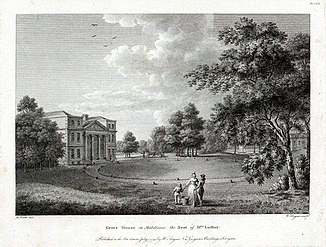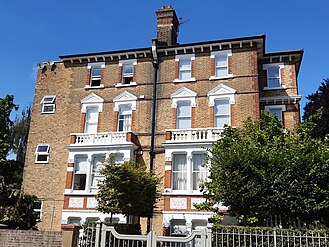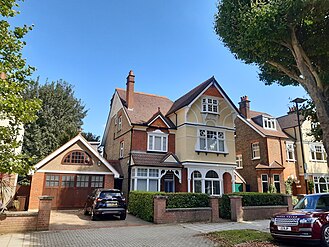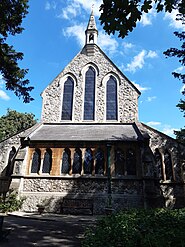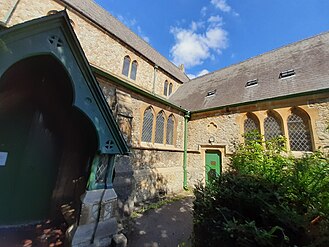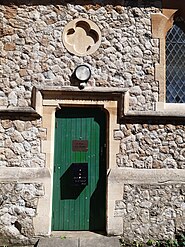Grove Park, Chiswick
| Grove Park | |
|---|---|
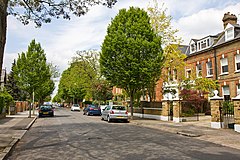 Grove Park Gardens | |
Location within Greater London | |
| London borough | |
| Ceremonial county | Greater London |
| Region | |
| Country | England |
| Sovereign state | United Kingdom |
| Post town | LONDON |
| Postcode district | W4 |
| Dialling code | 020 |
| Police | Metropolitan |
| Fire | London |
| Ambulance | London |
| London Assembly | |
Grove Park is an area in the south of
The architecture of the area includes houses in
Famous residents of Grove Park include the actor John Thaw, the soldier Bernard Montgomery, and the poet Dylan Thomas. St Paul's vicarage has repeatedly been used as a film set, including in Tinker Tailor Soldier Spy, Killing Eve, Lewis, Grantchester, and The Theory of Everything.
Geography
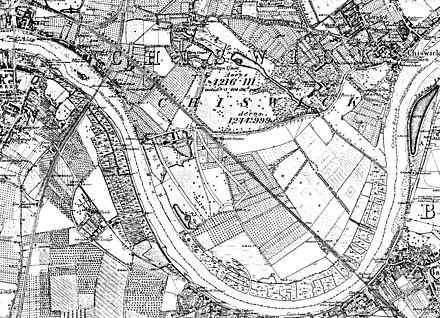
Much of Grove Park was still rural until late in the 19th century; the risk of flooding from the tidal Thames protected it from building.[2][3] One of the four constituent villages of Chiswick, Little Sutton, was in the Grove Park area, about the centre of the parish of Chiswick at that time; two other villages, Strand-on-the-Green and Old Chiswick, lie just to the west and to the east of Grove Park, respectively, with Turnham Green to the north.[3]
History
Grove House to housing estate
A house stood on the site of Grove House from 1412; it was replaced by 1705 with, according to a contemporary observer, "a spacious regular modern building ... pleasantly situated by the Thames side. Behind it are gardens by some said to be the finest in England".[4] Grove House was owned by the Barker family at that time; from 1745 it belonged to the Earl of Grantham and then to an eccentric animal-lover, Humphrey Morice.[4] The Duke of Devonshire bought the whole estate in the 1840s, reshaping Grove House without its third storey, and letting it to tenants.[4]
The building of the railways including Chiswick railway station in 1849 spurred development.[4][1] Grove Park Hotel was built in 1867, soon followed by housing.[1] Growth was slow but steady, with residential development accompanied by small-scale industry such as soap making.[1]
Robert William Shipway bought Grove House in the 1890s; it was demolished in 1928 and replaced by the houses on the west side of Kinnaird Avenue.[4]
-
Engraving of Grove House by W. Wade, 1792
-
Italianate"
-
Grove Park Hotel, 1867, now Station House
-
Grove Park Terrace level crossing
-
Large houses on Grove Park Road
-
Queen Anne Revival style, Spencer Road, c. 1890
-
The Turrets, a castellated house. 20th century
-
Corner house with round castellated tower, 20th century
St Paul's Church
The
-
St Paul's Church, Grove Park
-
Main entrance
-
Doorway Domus Dei Porta Coeli ("House of God, Gate of Heaven")
-
Altar and stained glass
-
Nave
-
Banner
-
The Transfiguration, after Raphael, late 16th century
St Michael's Church

St Michael's Church on Elmwood Road was designed by the architects
Parks and nature reserves
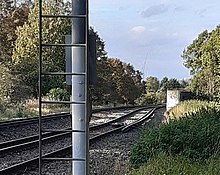
Just to the east of the Grove Park area is
In the First World War, a pleasure lake that had belonged to Grove House, at the southern end of Hartington Road, was turned into Cubitt's Yacht Basin; during the war it made cast concrete barges to carry ammunition. When the war ended it was used to moor houseboats.[8]
Residents
The actor
In culture
St Paul's vicarage was used in the 2011 film
References
- ^ ISBN 978-0550102591.
- ^ Bolton, Diane K.; Croot, Patricia E. C.; Hicks, M. A. (1982). "Chiswick: Growth". In T. F. T. Baker; C. R. Elrington (eds.). A History of the County of Middlesex, Volume 7, Acton, Chiswick, Ealing and Brentford, West Twyford, Willesden. London: British History Online. pp. 54–68.
- ^ a b Clegg 1995, pp. 6, 12, 17.
- ^ a b c d e Clegg 1995, p. 31.
- ^ Cherry & Pevsner 1991, p. 394.
- ^ a b c d "Our History". St Paul's Church, Grove Park. Retrieved 26 August 2021.
- ^ a b c d e Cherry & Pevsner 1991, p. 394
- ^ Baker 1982.
- ^ "50 Years Since Beatles Filmed Two Groundbreaking Music Videos". Chiswick House and Gardens. 20 May 2016. Retrieved 8 February 2023.
Sources
- Baker, T. F. T.; et al. (1982). "Chiswick: Growth". A History of the County of Middlesex: Volume 7: Acton, Chiswick, Ealing and Brentford, West Twyford, Willesden. British History Online.
- OCLC 24722942.
- Clegg, Gillian (1995). Chiswick Past. Historical Publications. ISBN 0-94866-733-8.


